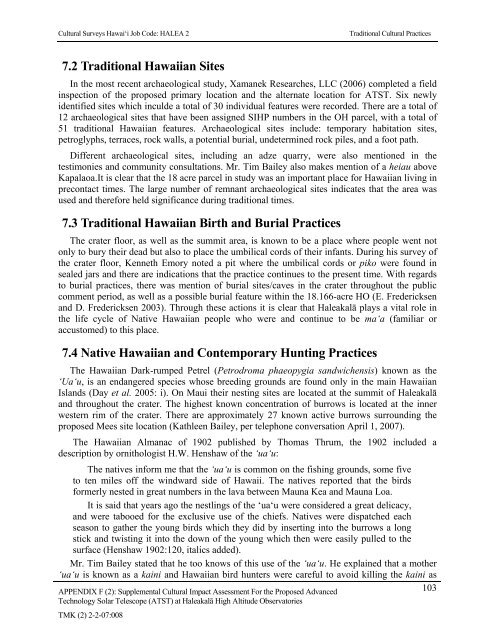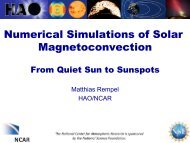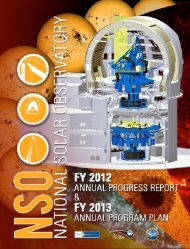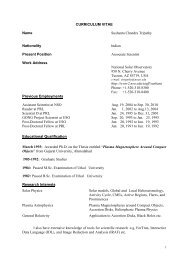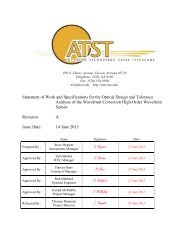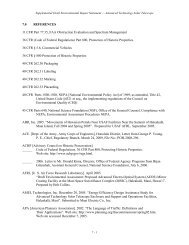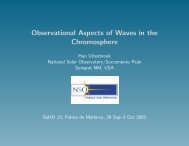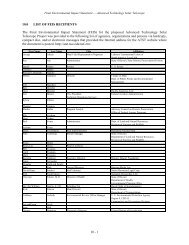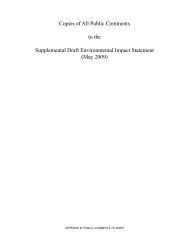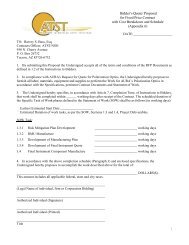Cultural Surveys Hawai‘i Job Code: HALEA 2Traditional Cultural Practices7.2 Traditional Hawaiian SitesIn the most recent archaeological study, Xamanek Researches, LLC (2006) completed a fieldinspection of the proposed primary location and the alternate location for <strong>ATST</strong>. Six newlyidentified sites which inculde a total of 30 individual features were recorded. There are a total of12 archaeological sites that have been assigned SIHP numbers in the OH parcel, with a total of51 traditional Hawaiian features. Archaeological sites include: temporary habitation sites,petroglyphs, terraces, rock walls, a potential burial, undetermined rock piles, and a foot path.Different archaeological sites, including an adze quarry, were also mentioned in thetestimonies and community consultations. Mr. Tim Bailey also makes mention of a heiau aboveKapalaoa.It is clear that the 18 acre parcel in study was an important place for Hawaiian living inprecontact times. The large number of remnant archaeological sites indicates that the area wasused and therefore held significance during traditional times.7.3 Traditional Hawaiian Birth and Burial PracticesThe crater floor, as well as the summit area, is known to be a place where people went notonly to bury their dead but also to place the umbilical cords of their infants. During his survey ofthe crater floor, Kenneth Emory noted a pit where the umbilical cords or piko were found insealed jars and there are indications that the practice continues to the present time. With regardsto burial practices, there was mention of burial sites/caves in the crater throughout the publiccomment period, as well as a possible burial feature within the 18.166-acre HO (E. Fredericksenand D. Fredericksen 2003). Through these actions it is clear that Haleakalā plays a vital role inthe life cycle of Native Hawaiian people who were and continue to be ma‘a (familiar oraccustomed) to this place.7.4 Native Hawaiian and Contemporary Hunting PracticesThe Hawaiian Dark-rumped Petrel (Petrodroma phaeopygia sandwichensis) known as the‘Ua‘u, is an endangered species whose breeding grounds are found only in the main HawaiianIslands (Day et al. 2005: i). On Maui their nesting sites are located at the summit of Haleakalāand throughout the crater. The highest known concentration of burrows is located at the innerwestern rim of the crater. There are approximately 27 known active burrows surrounding theproposed Mees site location (Kathleen Bailey, per telephone conversation April 1, 2007).The Hawaiian Almanac of 1902 published by Thomas Thrum, the 1902 included adescription by ornithologist H.W. Henshaw of the ‘ua‘u:The natives inform me that the ‘ua‘u is common on the fishing grounds, some fiveto ten miles off the windward side of Hawaii. The natives reported that the birdsformerly nested in great numbers in the lava between Mauna Kea and Mauna Loa.It is said that years ago the nestlings of the ‘ua‘u were considered a great delicacy,and were tabooed for the exclusive use of the chiefs. Natives were dispatched eachseason to gather the young birds which they did by inserting into the burrows a longstick and twisting it into the down of the young which then were easily pulled to thesurface (Henshaw 1902:120, italics added).Mr. Tim Bailey stated that he too knows of this use of the ‘ua‘u. He explained that a mother‘ua‘u is known as a kaini and Hawaiian bird hunters were careful to avoid killing the kaini asAPPENDIX F (2): Supplemental Cultural Impact Assessment For the Proposed AdvancedTechnology Solar Telescope (<strong>ATST</strong>) at Haleakalā High Altitude ObservatoriesTMK (2) 2-2-07:008103
Cultural Surveys Hawai‘i Job Code: HALEA 2Traditional Cultural Practicesthey were needed to raise their young. In addition to being a prized food source, ‘ua‘u were alsohunted for their feathers. The ‘ua‘u were the hō‘ailona, or the insignia, of some ali‘i, and thus,used by them in personal adornments such as capes. Certain ali‘i might be identified, not only bythe pattern in his or her feather cape, but also by the type of feathers and the distinct color of thefeathers. ‘Ua‘u feathers were also used as adornments on hula and lua instruments. Because ofof the birds’ migratory nature, following the seasons, ‘ua‘u feathers might have been used torepresent the season in which they appear. Lastly, ‘Ua‘u were considered ‘aumakua, a family orpersonal god (Pukui and Elbert 1986), who acted as a guardian. Today, it is illegal to harm or killthe ‘ua‘u as they are an endangered species and are protected by State and Federal laws.Concern for the ‘ua‘u was raised throughout the testimonies. Mr. Ki‘ope Raymond stressedthat the ‘Ua‘u is an ‘aumakua or family god and an endangered species. There is concern is thatthese endangered birds may be displaced, harmed or killed during construction as their burrowsare near the proposed site. Mr. Leslie Kuloloio says of the ‘Ua‘u, “[t]hat represents old Hawai‘i”(Table 3). Mr. Tim Bailey voices his concern about the ‘Ua‘u and the Native bat, ‘ōpe‘ape‘a(Table 3).Hunting practices are ongoing in the upland areas that border the National Park. The huntingof deer, goats, pigs, pheasant, chukar partridges, francolin and other game birds has become aculturally supported subsistence practice. In addition to subsistence hunting, feathers from somegame birds are highly prized for their use in hatbands.It was found that the Skyline Trail has been used by generations of hunters for access to theupper reaches of the Kula Forest Reserve. Another favorite hunting area is the Kahikinui ForestReserve. This forest reserve is located along the southern park boundary and is managed byLiving Indigenous Forest Ecosystem, (LIFE), a non-profit organization which works to keepferal animals and invasive species out of the reserve in an effort to help support the native forest.LIFE works in cooperation with Kahikinui Game and Land Management, a group allowed intothe reserve to hunt feral animals.7.5 Wahi Pana (Storied Place)Historical research, public testimonies and community consultations confirm that Haleakalā isa well known wahi pana. Its legendary status is not only known in Hawai‘i but throughoutPolynesia. It is at Haleakalā that one of the greatest deeds performed by the demi-god Māuioccurred, and although there are several variations of the legend of Māui snaring the sun, mostPolynesians are familiar with the tale. Traditional accounts of Māui’s deeds are found in theRichard Taylor compilation and it is in these collections that are found the closest ties with theMaori people of Aotearoa (see Section 3.1.1.2 Stories Collected by Taylor (1870)).Evidence of Māui’s importance resurfaces in several testimonies. Ms. Uilani Kapu explainsthat people come from Aotearoa to visit Haleakalā for spiritual purposes (Table 11). Mr. EdwinLindsey describes the Maori people of Aotearoa and their belief that Māui pulled their home,Aotearoa, up from the sea. He explains, “It [Haleakalā/Māui] is a spiritual entity that crisscrossesand has deep spiritual meaning to cultures not only here…but throughout Polynesia” (Table 3).Mr. Tom Cannon briefly relates the legend of Māui snaring the sun to slow it in its path acrossthe sky, so his mother would have more time to dry her kapa (Table 11). Ms. Leslie Ann Brucestates, “…as we all know, [Haleakalā] has mythological significance of the highest value. It is astoried place for the island’s namesake, Māui, who has Pan Pacific importance to manyAPPENDIX F (2): Supplemental Cultural Impact Assessment For the Proposed AdvancedTechnology Solar Telescope (<strong>ATST</strong>) at Haleakalā High Altitude ObservatoriesTMK (2) 2-2-07:008104


